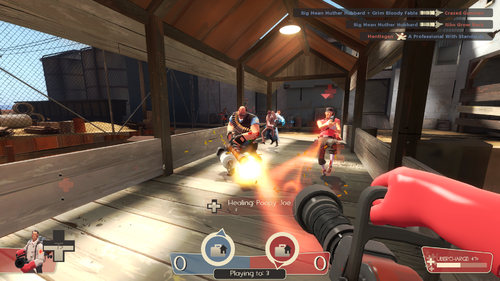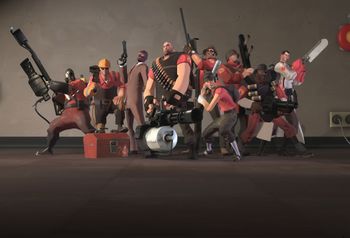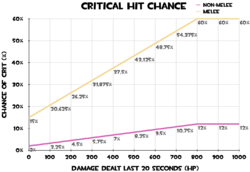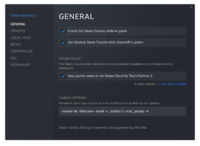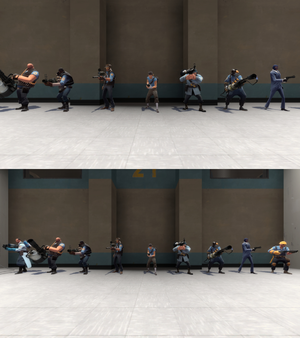机制
| 此页面正在被翻译成简体中文。 如果您能熟练地运用简体中文,请在讨论页上留言或与为此页面贡献的作者讨论(通过浏览页面历史)。 |
| “ | "而那就是你要做的,伙计!"
点击试听
— 士兵 炫耀自己的胜利.
|
” |
军团要塞2的机制给玩家,服务器和内容制作者定义游戏的规则和内容。 了解这些机制有助于更加简单和全面的进行游戏。
目录
引擎
军团要塞2使用的是橙盒版本的起源引擎,可以在Microsoft Windows, Xbox 360, PlayStation 3, Mac OS X 和 Linux 上运行. 橙盒版引擎在旧的起源引擎中添加了硬件面部渲染,柔滑粒子功能,和多重渲染功能。TF2针对24人形式(Xbox 360为18人 PS3为16人)或更少人的游戏大小进行了优化和平衡,尽管服务器可以开启32人的服务器(如果服务器能承受的了)(仅在PC/Mac)。所有玩家的行动和选择都由控制台命令和一个被称为Convars的变量所控制。
兵种
在"军团要塞2"中有9个兵种,他们被分类为3个领域"进攻型""防御型""支援型",尽管这些分类对游戏玩法并没有影响。兵种的能力和状态可以通过装备配置来改变。
 火焰兵: 进攻型兵种,拥有 100% 移动速度和 175 生命值, 适合近距离战斗和支援团队。能 点燃 敌人,使用 压缩空气来反弹飞行物和熄灭队友身上的火焰,不会受到后续燃烧的影响。火焰兵的默认配置是火焰喷射器 霰弹枪, 消防斧
火焰兵: 进攻型兵种,拥有 100% 移动速度和 175 生命值, 适合近距离战斗和支援团队。能 点燃 敌人,使用 压缩空气来反弹飞行物和熄灭队友身上的火焰,不会受到后续燃烧的影响。火焰兵的默认配置是火焰喷射器 霰弹枪, 消防斧
 医生:支援型兵种,拥有 106.67% 移动速度和 150 生命值,专注于提高队友的存活率和效率。能被动地恢复生命值,并能够治疗队友和部署ÜberCharge给队友和自己。医生的默认配置是 注射枪, 医疗枪, 骨锯
医生:支援型兵种,拥有 106.67% 移动速度和 150 生命值,专注于提高队友的存活率和效率。能被动地恢复生命值,并能够治疗队友和部署ÜberCharge给队友和自己。医生的默认配置是 注射枪, 医疗枪, 骨锯
 间谍:支援型兵种,拥有 107% 移动速度和 125 生命值, 适合隐蔽的破坏和暗杀。能够 伪装, 入侵, 隐形, 爆头 (仅在使用 大使手枪 是时候) 和 背刺. 间谍的默认配置为 左轮手枪, 电子工兵, 刀子, 伪装工具, 隐形手表
间谍:支援型兵种,拥有 107% 移动速度和 125 生命值, 适合隐蔽的破坏和暗杀。能够 伪装, 入侵, 隐形, 爆头 (仅在使用 大使手枪 是时候) 和 背刺. 间谍的默认配置为 左轮手枪, 电子工兵, 刀子, 伪装工具, 隐形手表
战斗
战斗是双方队伍达到目标的主要手段,军团要塞2有许多不同的战斗机制,如爆炸,步哨枪,霰弹枪等。
伤害
(也称为小爆击)
绝大部分的 武器 都可以对 生命值造成伤害. 除非服务器经过修改, 武器不会造成 友方伤害, 尽管有些武器能够伤害玩家自己。武器的伤害取决于多个变量, 大部分武器的伤害都与命中位置无关 (主要的例外是狙击手和间谍的 爆头 和间谍的 背刺).大多数武器对近距离的目标会造成更多的伤害,对远处的目标造成的伤害则会变少,迷你爆击和爆击的伤害不会受到距离因素的影响. 武器伤害是基于攻击者和目标被击中时之间的距离(而不是攻击者首次攻击时的位置)。当目标离爆炸中心的距离增加时,爆炸伤害就会减少。 虽然大多数爆炸性武器都会伤害他们的使用者,但是士兵和爆破手能够减免对自身的爆炸伤害。
除非服务器重新设置, 大部分武器都有随机的伤害修正值 (大约 ±15%) 并且能够半随机的变成 爆击.爆击不受伤害随机修正或基于距离的伤害修正,并且总是造成武器的基础伤害的300%。爆击通常带有团队颜色的色彩和电击的声音(最明显的是爆炸类武器) 通常,非近战攻击有2-12%的机会根据最近的伤害输出作为爆击的几率,而近战攻击有15-25%的几率; 然而,一些武器,像是 市场花园铁锹, 并不能造成随机爆击。 当被爆击攻击到时,文字会在目标的头像显示出来,并播放一个不同的音效,目标也会被强力地击退。爆击不会对自身造成额外的伤害和击退,尽管爆击击中自己时仍然有爆击的特效和音效让你觉得有。爆击伤害也不会叠加到单一的一次攻击。
一些武器和效果能造成 迷你暴击. 迷你爆击的功能类似于爆击,虽然他们只会造成135%的基础伤害,相比起爆击只提供较少的击退,并且和爆击有不同的视觉特效和音效。另外, 爆击伤害能够不受距离因素的影响,迷你暴击的伤害则差不多等于在近距离攻击敌人。如果一个攻击同时能够同时成为迷你爆击和爆击(类似于战旗加闪电战医疗枪同时激活),那它就会表现为爆击的形式。像爆击一样,迷你爆击也不会对玩家自身造成额外的伤害。
建筑 不会因为爆击或迷你爆击收到额外伤害, 也不会因为距离而减少受到的伤害。同样的,建筑的攻击伤害也不会受到距离的影响,也不能够造成爆击,但是能够通过一些正面影响来造成迷你爆击。(补充:给工程师的遥控手柄使用闪电战医疗枪,可以令建筑造成爆击伤害,因为伤害是计算在手柄上而不是建筑上)
命中判定
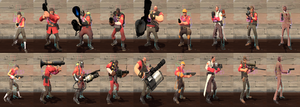
大多数武器是“飞行物武器”或“即时命中武器”。
- 飞行物武器, 像是 火箭发射器, 会发射出可移动的物件,路径,效果取决于服务器设定,这会令网络情况差的玩家获得不优秀的游戏体验。飞行物通常在发射后会产生独特的物理效果,玩家开火时的移动速度不会影响飞行物的速度。飞行物不是从屏幕中央生成的,而是从武器所在的一侧(右手的士兵从右手边发射火箭)。飞行物命中检测与玩家模型的命中判定区无关,相反,飞行物的命中检测依靠更大的一个可以包围住玩家,或者是与地图地形和物件碰撞的命中判定区来检测。并且不基于玩家兵种或状态而改变,除了蹲伏(举个栗子,一个站着的机枪手和一个正在跑的侦察兵有着同样的爆炸判定区,但是蹲伏的时候就不一样)火焰兵的火焰攻击是粒子效果,也遵循飞行物武器的命中规定。
- 即时命中武器, 像是 转轮机枪 可以直接命中敌人,而不像飞行物有飞行时间和范围命中判定。近战武器和子弹/霰弹武器通常也会造成即时命中。即时命中武器根据攻击者的游戏的判定(而飞行物的判定是依靠于服务器)确定命中,这可以产生有点奇怪的命中检测(“我已经找好掩体了;这是怎么打到我的?)。即时命中武器从屏幕的中央发射,即使看起来是从玩家手持武器的一侧发射的。非近战类型即时命中武器使用的是玩家模型的命中判定区(一个站着的机枪手的命中判定区会明显比一个站着的侦察兵大),近战武器使用的命中判定区是和飞行物的命中判定区一样大的。
武器种类
Each class has a unique set of weapons at their disposal occupying weapon slots 1, 2, and 3 (often referred to as primary, secondary, and melee, respectively). Some classes may have additional slots, such as the Engineer's PDA and Spy's Disguise Kit. The choices players make in choosing weapons and items constitutes their loadout.
Most non-melee weapons require Ammo for use. Weapons that use Ammo can be either reserve-based (having a limited clip size and requiring reloading from stored ammo, such as the Pistol) or fully-loaded (capable of using all ammo without reloading, such as the Minigun). Reserve-based weapons either use magazine-style reloading (reload fills loaded ammo in single, one-time animation, such as the Revolver) or sequential reloading (reloads ammo from reserve one at a time, such as the Shotgun). Reloading can be interrupted at any time by attacking or changing weapons, though time spent reloading (beyond the last carried ammo increment, in the case of sequential weapons) is wasted. When reloading a sequential reload weapon, a different animation and reload time is used for reloading the first ammo and subsequent ammo (for example, an emptied Grenade Launcher takes 1.24 seconds to reload 1 ammo, plus 0.6 seconds for each ammo after that).
Many weapons that don't use ammo must be recharged instead (such as Jarate). Recharging can usually be done by waiting for a set amount of time, going to the resupply cabinet, or respawning. Some weapons without ammo require manual refill based on specific requirements, such as the Medi Gun (which requires refill for ÜberCharge, though not for healing) and the Buff Banner.
角色状态
[[Image:ÜberCharge Kritzkrieg.png|thumb|right|350px|医生的闪电战医疗枪的爆击加成效果下的机枪手。机枪手也在侦察兵的疯狂的牛奶的效果下。
Status effects include a variety of weapon-induced player conditions, such as Fire and Bleeding. All status effects are removed by death, touching a Resupply Locker or class change, and most negative effects are removed by ÜberCharge. Some can be removed by healing or submersion in water. There are both positive and negative effects.
正面效果
- ÜberCharge: An ÜberCharged player is invulnerable to all forms of damage other than environmental hazards or a Telefrag. ÜberCharged players can be identified by their bright team-colored shimmer and glowing eyes. Caused by the Medi Gun, escaping from Eyeaduct's Underworld, Ghost Fort's Skull Island and stunning Merasmus with a bomb.
- Megaheal: A player under this effect is immune to movement-impairing effects (such as knockback, stun, and slowdown) and is healed at 100.8-302.4 HP per second (depending on how recently the player was damaged), or 3x the Quick-Fix's base heal rate. Megahealed players have a glowing ring around their feet, similarly to the Buff Banner. Received by the Quick-Fix's ÜberCharge.
- Crit boost: All attacks from a player under the effects of a crit boost result in Critical hits. The weapons of such a player glow with team-color electricity. Received by the Kritzkrieg, the Killing Gloves of Boxing, Frontier Justice, the Diamondback, the Chargin' Targe, the Splendid Screen, and the Phlogistinator; also occurs after capturing the Intelligence and attaining First Blood on most servers, collecting a Halloween pumpkin on a Haunted Halloween Special, escaping from Eyeaduct's Underworld or Ghost Fort's Skull Island, or for the winning team during humiliation. The Cow Mangler 5000 cannot be forced to crit, even during a crit boost.
- Mini-crit boost: Attacks from a player in a mini-crit boost will all be mini-crits. Mini-crit boosted weapons glow with electricity based on team color, with a slight yellow tint (greenish blue for BLU, orange for RED). Received by Crit-a-Cola, Buff Banner, Chargin' Targe, Splendid Screen, Tide Turner, Buffalo Steak Sandvich, and the Cleaner's Carbine.
- Overheal: An overhealed player's health is above 100% (limited to 150%). Overhealed players emanate health icon-shaped, team-colored particles. Received by the Medi Gun, Kritzkrieg, Vaccinator, Quick-Fix, Eyelander/Nessie's Nine Iron/Horseless Headless Horsemann's Headtaker, Powerjack, Conniver's Kunai, Dalokohs Bar/Fishcake, and escaping from Eyeaduct's Underworld.
- Evasion: Evasion prevents enemy weapons from damaging a player, though it has no impact on knock back or the induction of status effects. Evasive players produce an afterimage distortion effect behind them, and attacks against them cause flashes of text indicating misses. The only item to cause this effect is Bonk! Atomic Punch.
- Hype Mode: Hype mode allows the player (as the Scout class) to perform 5 additional air jumps while the effect is active. A magenta glow is applied to the player's active weapon. The only item to cause this effect is the Soda Popper.
- Speed Boosted: A 40% speed boost is applied, which caps at 150% of the basic move speed. Speed-boosted players are indicated by a wind breeze particle effect surrounding them. Received by Disciplinary Action, the buff from The Concheror, getting a kill with the Big Earner, feigning death with the Dead Ringer, and hitting an enemy with the Eviction Notice, as well as escaping from Eyeaduct's Underworld or Ghost Fort's Skull Island, and going through the door on the clock tower in Helltower.
- Damage Softening: Players benefiting from damage softening receive reduced damage and knock back from Critical hits and mini-crits, and take an additional 35% reduced weapon damage overall. Such players have a glowing ring around their feet (an effect shared by the Buff Banner's Crit boost effect). Received by the Battalion's Backup.
- Resistance: Players can have 1 of 3 resistance types deployed on them. Those resistance types are called Bullet Resistance, Blast Resistance, and Fire Resistance. These Resistance types can be deployed as a ÜberCharge with the Vaccinator equipped.
负面效果
- Fire: A burning player takes damage over time (an effect known as Afterburn), to which Pyros are immune. From most sources, this deals 3 damage every half-second over 10 seconds for a total of 60 damage (Degreaser only deals 2 damage at a time, totaling 40). Received by the Flamethrower, Backburner, Degreaser, Phlogistinator, Rainblower, Nostromo Napalmer, ignited arrows, Flare Gun, Detonator, Manmelter, Scorch Shot, Sharpened Volcano Fragment, Huo-Long Heater and the charged shot from the Cow Mangler 5000.
- Bleeding: Bleeding players take damage over time. Bleeding duration is based on the source (either 5 or 6 seconds), dealing 3-5 damage every half-second. Received by the Southern Hospitality, Tribalman's Shiv, Boston Basher, Three-Rune Blade, Flying Guillotine and the projectile (bauble) from the Wrap Assassin.
- Slowdown: The enemy's movement speed is reduced. Received only by getting hit with Natascha.
- Jarate: Attacks made against Jarate-soaked players become mini-crits. Jarate-soaked players are tinted yellow and drip yellow droplet particles, which partially reveal cloaked Spies. Received by Jarate and the Sydney Sleeper.
- Milk: Players who attack Milk-soaked enemies are healed for 60% of the damage dealt (does not overheal). Milk-soaked players drip white droplet particles, which partially reveal cloaked Spies. Received by Mad Milk. Can be upgraded to any Medic Primary (excluding the Crusader's Crossbow) in Mann vs. Machine.
- Fleeing State: Fleeing players move 10% reduced speed, cannot move while crouched, and cannot fire or change weapons (although they can taunt). Such players can be recognized by their change in character animations, which vary by class (most can be characterized as looking "frightened" or "disappointed"). Received by the Sandman, humiliation, Ghosts, and the Horseless Headless Horsemann's "taunt".
- Marked For Death: Attacks made against players who are Marked For Death become mini-crits. A player who is marked for death has a white skull and crossbones image above their head. Unlike Jarate, Mark For Death can't be removed by being submerged in water nor being healed by a Medic. The only cures are touching a Resupply Locker or waiting it out. Scouts can Mark enemies For Death with the Fan O'War, Soldiers are Marked For Death while using the Escape Plan and for three seconds after switching weapons, Heavies are Marked For Death while using the Gloves of Running Urgently and for three seconds after switching weapons, and Engineers are Marked for Death when hauling a building with the Rescue Ranger equipped (whether picked up from a distance or not) and for three seconds afterward. As well as that, in MvM, the Sandman can be upgraded to apply a mark for death upon any robots the baseball hits.
击退
[[Image:Pyroblows.png|thumb|right|100px|一个火焰兵在侦察兵身上使用压缩空气。
Most weapons produce at least some sort of knockback, much of which is too small to notice. Attack modifiers to knockback include damage, critical hit or mini-crit status, and weapon-specific effects. Knockback can be used to manipulate the positioning and movement of players, especially those of enemies through juggling, and oneself through rocket jumping or sticky jumping. Some weapons and abilities, such as the Force-A-Nature and compression blast, are based on unique knock back functionality. ÜberCharged targets are less influenced by enemy knockback than normal targets, and Megahealed players and Disguised Spies are not subject to knockback from enemy weapons, but a compression blast will affect Disguised Spies.
环境
Depending on the map and server, the goals and rules of TF2 gameplay can change dramatically. By understanding these variables in gameplay (and how to parse them in the Server Browser), players can find a game environment that suits them and fully contribute to their team's goals.
目标
[[Image:GravelPitDefense.jpg|thumb|right|400px|一个防御的队伍在Gravel Pit上坚守着一个控制点。
Maps are made based on a variety of game modes, which are used to determine the objectives for both teams. Teams may compete over the same goals (such as in Push Control Point and King of the Hill maps) or oppose each other in an offense vs. defense setup (such as in Attack/Defend Control Point and standard Payload maps).
Many game modes use control points. Control points begin to be captured when a player of a team not owning the point stands on the point. The capture time varies by map, and its speed is increased when more players stand on it (though each player beyond the first provides diminishing returns). Capture is halted when an opposing team member stands on it in defense, and capture progress is gradually undone when no capturing teammates stand on the point. Control points cannot be captured while "locked", and locked points are usually unlocked after preceding points are captured. Payload carts are pushed and halted the same way control points are captured, though instead of capturing a Payload cart, the pushing team tries to bring it to a checkpoint. ÜberCharged players cannot capture points or push carts, though they can defend them.
In official maps with offense vs. defense game modes, BLU plays offense while RED plays defense. In such maps, BLU tends to have faster respawn times, but RED is given a setup time to prepare a robust defense.
- Arena: Players spawn only at the beginning of the round, with no respawning. After a set time, a neutral control point unlocks, which can be captured to win the round. If all members of a team die, that team loses the round. Has First Blood and automated team assignment/shuffling by default. Official arena maps don't have resupply Lockers.
- Capture the Flag (CTF): Teams work to capture the opposing side's Intelligence faster than their opponents do the same. Any player can pick up an enemy's Intelligence, and their team gains a point if that player returns the enemy's Intelligence to their team's own original Intelligence spot. The Intelligence drops on command or when its carrier dies; it is returned to its original location if it remains on the ground for a set time after being dropped.
- Control Point, Push (CP): Each team starts with two locked control points and fight for the middle, neutral control point. From then on, at any given time, each team's furthest control point is unlocked, while all others are locked. Teams must capture all five control points to win the round.
- Control Point, Attack/Defend (CP): If the offensive team captures all of the defense's control points before time runs out, they win (if the defense can prevent this, they win). In most maps, only one or two control points are unlocked at a time (the notable exception being Steel).
- King of the Hill (KOTH): Each team has their own countdown timer, and a team wins when their countdown timer reaches zero. A team's timer counts down while they own the control point, but is frozen while that team does not have ownership of the control point. Note that a team's timer will still count down even if there are enemies trying to capture the point.
- Mann vs. Machine (MVM): A team composed of up to six human players must fend off waves of AI-controlled robots, stopping them from delivering a bomb to the map's stronghold. Players are able to collect cash from destroyed robots and buy upgrades between waves. Offense wins if successfully deliver the bomb, while defense wins by successfully Ward off all the waves.
- Payload (PL): Offense pushes the Payload cart in a manner similar to capturing a control point, trying to reach checkpoints instead of finishing point captures. The Payload cart supports allies as if it were a level 1 Dispenser. Offense wins if the cart reaches the final checkpoint, while defense wins by making sure the cart doesn't reach the final point before the timer counts down to 0.
- Payload Race (PLR): Essentially identical to Payload, but instead of offense vs. defense, each team pushes their own cart in an attempt to reach the finish before the opposing team does.
- Special Delivery (SD): CTF-streetball, an initially neutral briefcase of Australium must be transported to Poopy Joe's rocket before the opposing team can do the same.
- Territorial Control (TC): Each team is randomly assigned territories, and rounds consist of each team trying to contest one of their opponent's control points (while the opposing team tries to capture one of theirs). Most of the map is locked during gameplay, consisting of only one territory vs. one territory. After enough successive wins, another round takes place at the losing side's base point, which they must defend against the offense-only opposing team.
- Training Mode (TR): Training maps are for practicing skills against obstacles and/or bots and learning through tutorials. They are often played with only one human player, or at the very least, no opposing human sides.
地图元素
[[Image:Pickups.png|thumb|300px|right|左到右:100% 大型医疗包,三明治,50% 弹药箱。
Players start the round in their team's resupply room, where they can change class and loadout instantly. Most resupply rooms contain cabinets, which fully restore health, restock weapon ammo, refill most item meters, and remove most negative status effects, though a similar effect can be achieved by class switching. Upon dying, a player waits to respawn in a respawn wave, which typically comes at ten- or five-second intervals, but do vary by map, team color and size, objective status, and server settings. After this wait, they appear at their team's furthest forward resupply room. Resupply rooms can be earned by capturing points or pushing Payload carts to checkpoints and can be lost if the opposing team makes such progress themselves.
Many maps make use of doors. Although their visuals suggest otherwise, doors are handled by the server as being either completely open or completely shut, alternating between the two instantly. Most doors are opened whenever a player stands near them. However, some doors will only open to players coming from a certain side or players on a certain team, most notably resupply room doors. Some doors remain locked until certain conditions are met, such as control points being captured or Payload cart checkpoints being reached.
The boundaries and surfaces of maps are not determined by visual elements, but invisible surfaces that determine where players and projectiles can go. All maps--even outdoor ones--have player ceilings and walls, though they may be invisible, and projectiles may even appear to go through them. Additionally, many surfaces and objects in the game that appear to take physical space are completely ignored for collision detection, with players and projectiles passing through them as if nonexistent; these surfaces can be used for hiding Stickybombs or spamming targets from cover.
Maps usually have pickups placed in various locations. Map-specific health and ammo pickups will remain in place until grabbed, respawning after a ten-second delay. The map health pickups restore 20.5%, 50%, or 100% health based on size (pill bottle, first aid tin, and ice cooler, respectively); similarly, the map ammo pickups restore 20.5%, 50%, or 100% ammo and 41, 100, or 200 metal based on size (small grey metal box, medium beige metal box, and large wood crate, respectively). When players die, they usually drop weapons that can be picked up for 50% ammo and 100 metal (unless the dropped item was an Engineer toolbox, which drops 100% ammo and 200 metal); destroyed buildings also leave behind metal debris, which can be picked up for ammo and metal. A Heavy who dies with a Sandvich, Dalokohs Bar, Fishcake, or Buffalo Steak Sandvich active will instead drop that, which can be picked up for 50 health points (75 for Scouts).
Several elements can be found in places where many players may go to if needing a health kit or ammo. A player who cannot find health kits or ammo may find an Engineer's Dispenser to get some, or if there is no Dispenser, go to spawn.
服务器设置
Server settings can have a strong impact on gameplay in terms of performance and game balance. Players can select what kind of server on which they want to play using the Server Browser, filtering based on tags (which include game modes and changes to respawn times), player count, map, latency, and the like. Generally, servers closer to the player's location will have reduced latency, resulting in faster connection and more accurate hit detection. Game smoothness is also affected by the server's hardware and networking settings, especially at higher player counts or when running some mods.
Servers can run scripts and configs just as a player can, with commands from clients issued by rcon. For additional functionality, there are numerous server plugins to modify gameplay or provide administrative or stat assistance, the most common being SourceMod and HLStatsX. Instead of running plugins, servers can use logs to interact with third-party matchmaking programs, such as TF2 Lobbies, which let them see stats out-of-game.
There are a variety of server settings that can change gameplay without running plugins or external programs. These can include:
- Respawn times: Respawn times can be changed to either be shorter or effectively removed entirely. These can cause fluctuations in map and class balance, though combat is more steadily provided.
- Damage settings: Servers can disable random Critical hits, random damage spread, and random pellet spread with ConVars. This is most commonly done on competitive servers and those that frequently play arena maps.
- Max players: While TF2 was originally designed for 24 players or fewer, servers can raise the limit to 32 at the cost of performance. This can cause an increase of spam that slows objective progress but ensures a greater amount of combat in the map.
- Objective specifics: Map objectives can be specified from the server. For example, the CTF game mode can be played to a certain capture count, to a certain time limit, or both. Related options include disabling Crit boosts from First blood or Intelligence capture, changing the map time limit, and using a win difference mercy rule.
- Pure: The sv_pure ConVar dictates what kinds of custom files are allowed on the server. When set to 0, clients can use any custom content they wish. When set to 1, clients are allowed to use any files on the server's whitelist. When set to 2, clients may not use any custom content besides those specifically allowed by Valve.
- SourceTV: Servers can enable SourceTV to allow a large number of spectators to watch the game without risking interference. SourceTV acts like an observer player, taking up a server slot while not playing on either team. Unlike players, SourceTV broadcasts its spectator view from the server's IP address (using a different port).
- Special modes: There are server modes that can be applied to any map regardless of game mode, including highlander and tournament modes. These are more commonly reserved for private events and competitions.
Other common rule areas that can vary by server include team size/balance rules, alltalk (cross-team) voice chat, and ping limits.
结构
There are a variety of ways to configure the Team Fortress 2 client. The choices players make in setting up TF2 can have impacts on game interaction, performance, and presentation. Most of these methods of customization are not available on console versions of the game, save main menu options.
准备阶段
Some aspects of a player's machine, operating system, and Steam settings can affect TF2, and after a long history of updates, Team Fortress 2 has required an increasing amount of system resources to play at optimum frame rates. Additionally, some program features enabled by default may be undesirable for certain players, either due to performance issues or personal preference.
Steam, by default, enables both Steam Cloud synchronization and the Steam Community In-Game Overlay, which can be changed under Steam Settings. Within Steam's interface, players can also change launch options. As the name suggests, launch options are TF2 settings that are applied when the game is launched. Launch options can be accessed by opening the Properties of Team Fortress 2 in the Steam Library and clicking "Set Launch Options...". Launch options are separated by spaces and start with either a dash (if the command is not accessible through console commands) or a plus sign (if the command is a console command). Launch options can be used to achieve a variety of effects, including...
- Smooth Alt+Tabbing: Players who wish to view other windows and programs while running TF2 can run it in windowed mode with no border. This can be reversed with the full-screen launch option (-full). Example (for 1440x900 resolution): -window -noborder -w 1440 -h 900
- DirectX Level: Due to performance or personal preference, running TF2 in a low DirectX level may be ideal. Example (for DirectX 8.1): -dxlevel 81
- Disabling Extraneous Features: Memory usage and performance drops can be minimized by disabling unused features. Example: -novid -nojoy -noipx -nocrashdialog
In addition to the Steam options, launch options can be specified for individual shortcuts to Team Fortress 2 by adding them to the file "C:\Program Files\Steam\Steam.exe" -applaunch 440 as a shortcut target. For example, this shortcut target would run TF2 full-screen with no intro video:
"C:\Program Files\Steam\Steam.exe" -applaunch 440 -full -novid
Video card and sound card configuration tools can be used to override game settings. For example, some video card utilities can change mat_picmip to values outside the normally allowed bounds in Team Fortress 2, though this can be considered cheating.
Team Fortress 2 can be subject to operating system influences on mouse control. While this can be mitigated through launch options and registry edits, the easiest method to override this is by enabling Raw input (m_rawinput 1).
可定制内容
The most straightforward way for a player to customize their TF2 experience is the in-game options panels. In essence, the options panels are user-friendly ways to set ConVars, which can otherwise by set manually using the developer console. These panels are...
- Keyboard: Allows for simple key binding (can be done in command console with bind "KEY" "COMMAND"). The advanced options allow for fast weapon switching (change slots without confirming with the attack key) and enabling developer console (an important option for anyone using console commands).
- Mouse: Contains options for mouse and gamepad control. The "Raw input" option gives users more reliable mouse aiming by bypassing operating system mouse settings.
- Audio: Has a variety of sound-related options. Closed captions do not work without custom files.
- Video: Allows for some control of display settings, though some settings found in launch options and FPS configs are missing or disabled. The advanced video options panel has the field of view (fov) slider, which can be increased to grant the player wider vision in-game.
- Voice: Has simple controls for in-game voice chat.
- Multiplayer options: Contains a great variety of gameplay-related options (mostly in advanced options) and content download control.
These settings are stored as ConVars in config.cfg, found in the cfg folder (which is usually found in C:\Program Files\Steam\steamapps\STEAMLOGIN\team fortress 2\tf\). By default, config.cfg is saved to the Steam Cloud.
In addition to the menu panels, ConVars can be changed with more specificity using scripting. Scripting allows for more advanced and uniquely tailored controls, dynamic player settings, and more optimized performance (performance scripts are usually just called "configs"). Script files are located in the cfg folder (usually found in C:\Program Files\Steam\steamapps\common\team fortress 2\tf\). The file autoexec.cfg runs on game startup, and the class-named files (such as scout.cfg) each run when first spawning as the appropriate class. Most scripts are made using bind, alias, game commands, and/or ConVars; the wait command may be used to produce automated, chronologically sequenced functions, though a number of servers disable this with sv_allow_wait_command 0.
Many aspects of the TF2 interface can be customized by editing the Heads-up display, or "HUD". Most custom HUDs always work regardless of server settings, unless the HUD uses customized material files, which constitute custom content and are disabled by sv_pure servers (most HUDs only contain /resource/ and /scripts/ files, which are allowed in all pure settings).
工具
There is a variety of first-party (some in-game and some not) and third-party tools to assist in playing, editing, and analyzing Team Fortress 2. These can include:
- Demo Recording and Playback: Players can record demos of gameplay (record FILENAME in console) to watch or share later without using the resources necessary for live video capturing. Demos can be played with the console command playdemo FILENAME and captured to video using the startmovie command. PREC is a common, Valve-approved add-on to TF2 that automates demo recording.
- TF2 Tool Mode: TF2 can be run under a "tool mode" with the launch option -tools. The tool mode allows access to the Commentary editor, Material editor, and perhaps most notably, the Particle editor.
- Source SDK: The Source Engine Software Development Kit, or SDK, is a set of programs that come with all Source engine games and run through Steam, including the Model Viewer (commonly used for posing wiki images) and Hammer editor (used for making maps). The SDK can be accessed in the Tools subsection of the Steam Library and has its own wiki.
- GCFScape: One can examine and extract the contents of TF2 using GCFScape, a third-party application used by most custom content editors. GCFScape can also be used to validate or defragment game files. In order to view and edit VTF files extracted using GCFScape, VTFEdit is commonly used.
These tools, in addition to modeling and sound editing software, can be used to edit a variety of TF2 gameplay elements, though their actual presence in-game is based on server settings (most notably with the sv_pure command and file whitelists).
User-made content can be submitted to Valve through the Steam Workshop. Content deemed worthy of inclusion becomes official game content, with the author credited and rewarded for their contribution.
参见
额外链接
